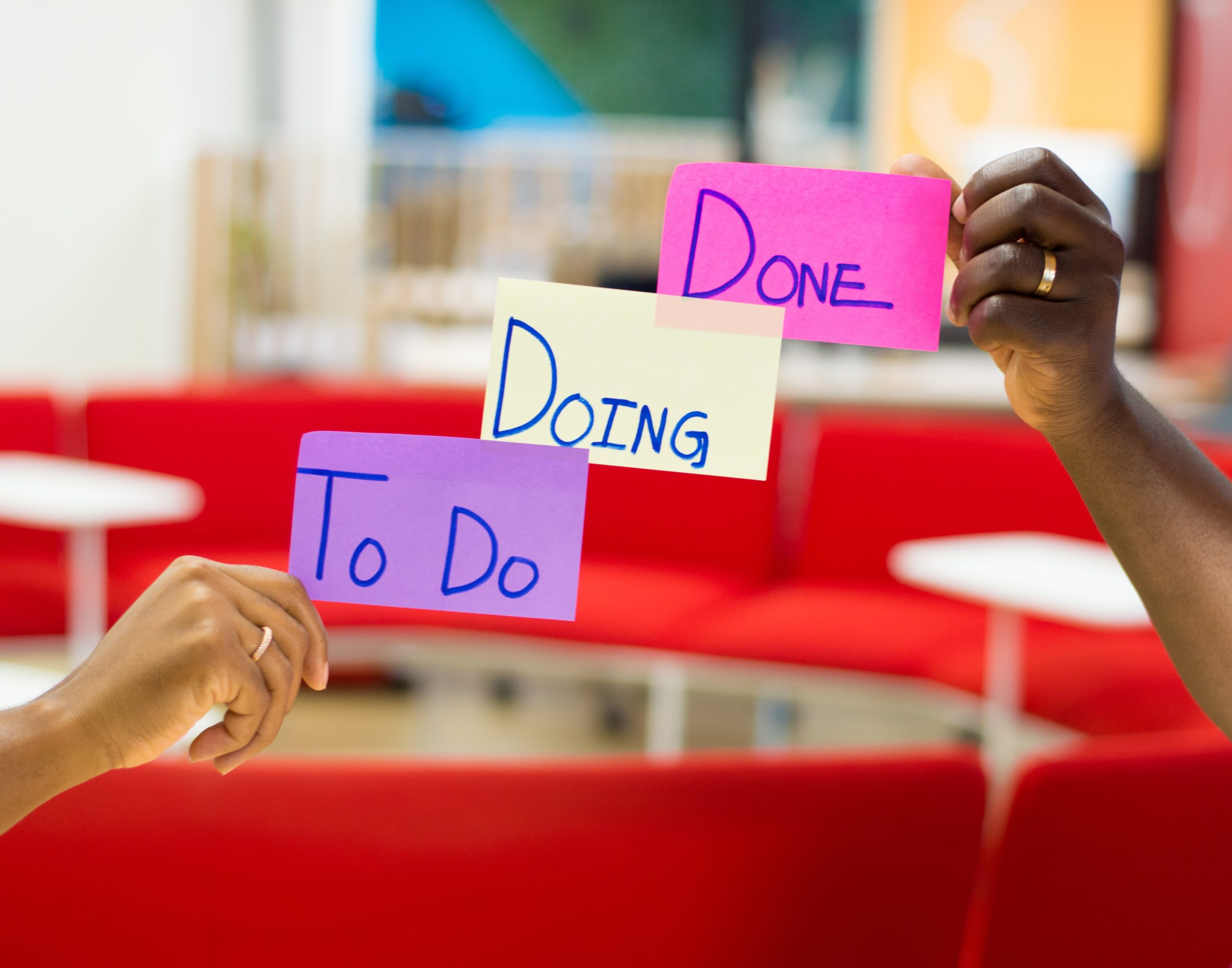Are you a teacher looking for new and exciting methods to engage your students and keep them focused during your lessons? Project based learning is the answer you’ve been longing for.
We’re CareerBridge Europe, an educational center in Tenerife, Spain, and we want to share with you a way of learning that works for us: Project Based Learning!
With Project Based Learning (short PBL), not only will your students be engaged and interested in class, but their academic performance will also improve considerably.
Both students and teachers benefit from this, so why waste time? Learn more about this revolutionary teaching technique, and let us know how your classes have improved since implementing PBL.
What is Project Based Learning (PBL)?
First things first, what does Project Based Learning involve, and why is it useful?
Project-based learning is an innovative teaching method that focuses on real-world, problem-based projects to motivate and engage students.
This teaching method focuses on the learning experience as a whole, rather than on the outcome of it.
The project itself is the primary vehicle for learning, and students are given the opportunity to explore a topic in depth, apply their knowledge and skills, and communicate their learning to others.
As a result of PBL’s proactive approach, students are encouraged to express and develop their ideas, which is vital to solidifying their knowledge.
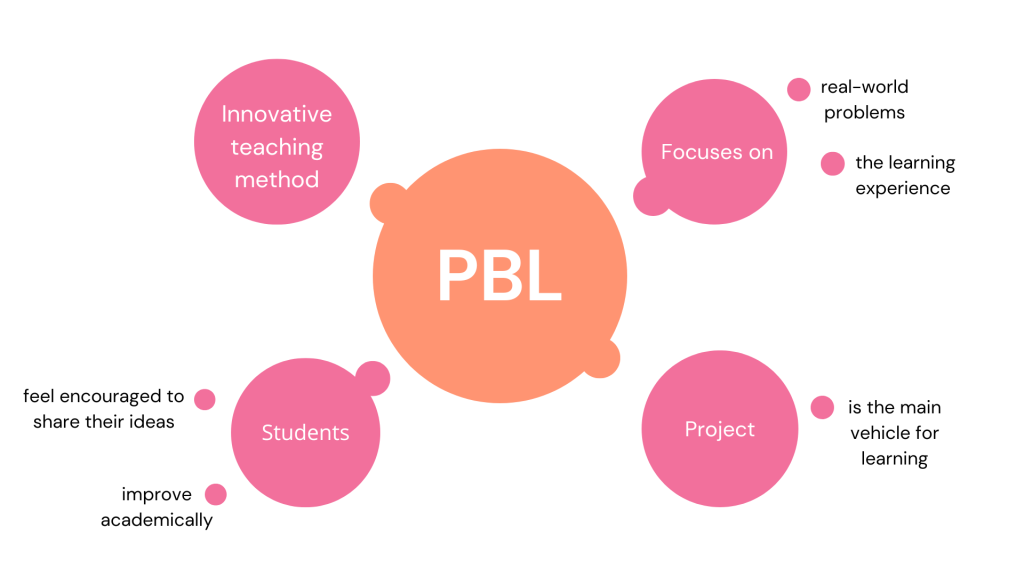
Isn’t PBL “just doing a project”?
Project Based Learning isn’t just a teaching approach, it’s also a mentality that conditions your entire teaching practice. While simply doing a project is just a momentary experience inside your subject’s curriculum, PBL is more like a permanent state of mind.
Here you can see how PBL differs from “just doing a project”:
- PBL focuses on learning and student engagement: the project itself is the primary vehicle for learning, and students are given the opportunity to explore a topic in depth, apply their knowledge and skills, and communicate their learning to others. Its goal is to engage students and promote deeper understanding and retention of material.
- PBL involves problem-based or inquiry-based pedagogy : students are presented with real-world problems or challenges to solve, or are given the opportunity to pursue their own interests through inquiry.
- PBL involves a high degree of student autonomy: students are given the opportunity to take ownership of their learning and pursue topics that are of personal interest to them. They’re also given the freedom to explore and make decisions about their learning, with support and guidance from their teacher.
Simply doing a project, on the other hand, may involve completing a pre-determined task or following a set of instructions, with focus on producing a finished product rather than on the learning and engagement process.
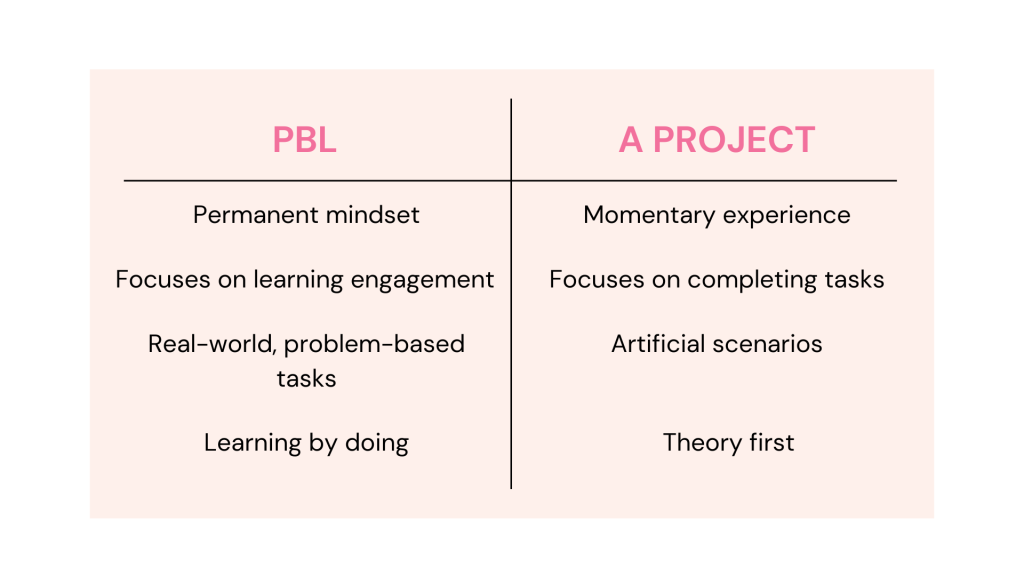
Benefits of PBL
One of the key benefits of PBL is that it allows students to apply their knowledge and skills to authentic, meaningful tasks. This type of learning is highly relevant and engaging for students, as they’re able to see the value and purpose of what they’re learning.
In addition to promoting deeper understanding and retention of material, project-based learning also helps students develop important 21st century skills such as collaboration, communication, problem-solving, and critical thinking. These skills are essential for success in today’s world, and project-based learning provides a unique opportunity for students to practice and develop them.
Another advantage of project-based learning is that it allows for a wide range of student interests and learning styles to be addressed. Projects can be tailored to individual students or groups, and students are able to take ownership of their learning and pursue topics that are of personal interest to them.
In a nutshell, PBL:
- Promotes deeper understanding and retention of material: PBL encourages students to explore topics in depth and put their knowledge into practice in an authentic, meaningful way.
- Develops important 21st century skills: PBL helps students develop skills such as communication, problem-solving, and critical thinking.
- Engages and motivates students: PBL is highly engaging and motivating for students, as they can pursue topics of personal interest and take ownership of their learning.
- Fosters creativity and innovation: PBL allows students to think creatively and explore new ideas and approaches to solving problems. This fosters innovation and encourages outside-the-box thinking.
- Improves collaboration and teamwork: PBL requires students to work together in teams to research and solve problems. This promotes collaboration and teamwork skills, which are crucial in today’s modern world.
- Increases student autonomy and agency: PBL allows students to take ownership of their learning and make decisions about their learning process. This increases student autonomy and agency, and helps students develop independence and self-direction.
- Supports differentiation: PBL can be tailored to meet the needs and interests of individual students or groups, making it an effective method for supporting differentiation in the classroom.
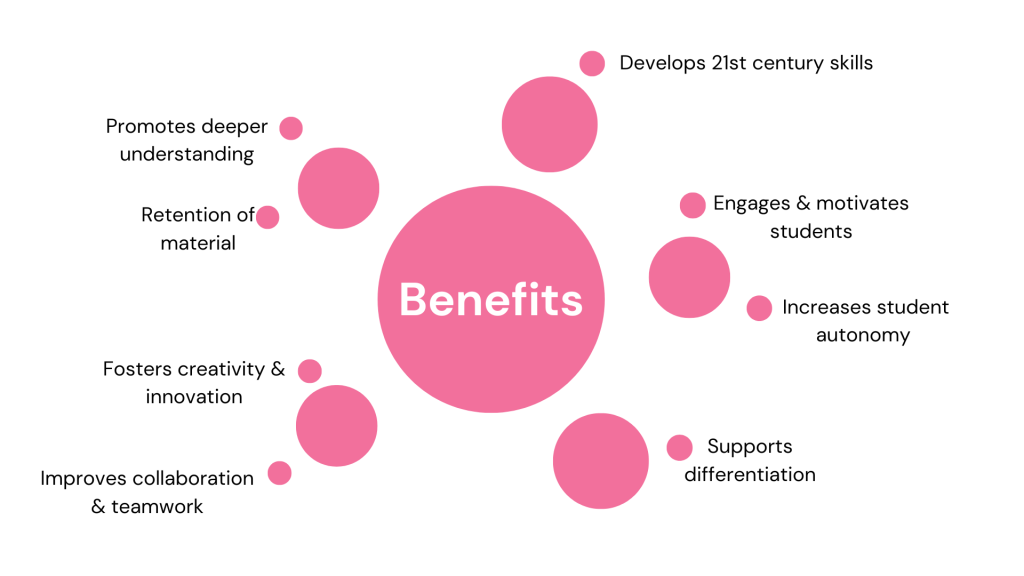
How to PBL?
There are a few important factors to keep in mind when implementing PBL in the classroom. It is important to carefully plan and structure the project, ensuring that there are clear goals and expectations. It is also important to provide support and guidance to students as they work on the project, but also to give them the autonomy to explore and take hold of their learning.
Want to revamp your classes with PBL? Here’s how:
- Identify the learning goals: Begin by identifying the learning goals for the project. What do you want students to know or be able to do as a result of the project? Make sure the goals are clear and specific, and align with your curriculum.
- Choose a project topic: Next, choose a project topic that is engaging and relevant to your students. Consider their interests and abilities, and try to select a topic that will allow them to apply their knowledge and skills to authentic, meaningful tasks.
- Design the project: Design the project with the learning goals in mind, and consider how students will be able to apply their knowledge and skills to the project. Include a variety of resources and tools that students can use to research and solve the problem or create a product.
- Provide support and guidance: As students work on the project, provide support and guidance as needed. This may include feedback on their progress, help with research and resources, and guidance on how to solve problems or make decisions.
- Assess student learning: Assess student learning throughout the project, and provide feedback to help them improve their work. You may choose to use a variety of assessment methods, such as self-assessment, peer assessment, or teacher assessment.
- Reflect on the project: After the project is complete, have students reflect on their learning and the process they went through. This can help them understand what they learned and how they can apply it in the future.
Overall, it’s important to carefully plan and structure the project, while also giving students the autonomy to explore and take ownership of their learning, here’s where the difficulties of PBL lie.
However, by following these steps you can rest assured that you can successfully implement PBL in your classroom and provide a meaningful and engaging learning experience for your students.
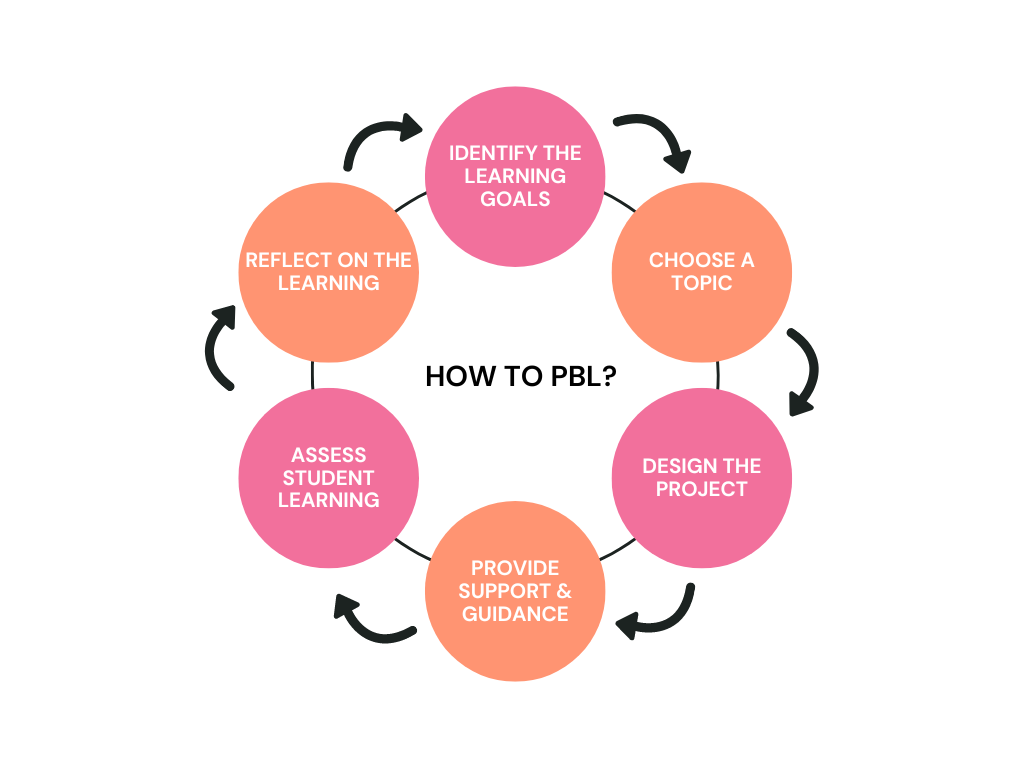
Gold Standard PBL
Gold Standard PBL is an easy-to-follow guideline that helps teachers, schools and other educational institutions implement, measure and adjust Project Based Learning teaching practices to meet the current learning situation in their classrooms.
Although every education provider establishes their own standards, they all share a common denominator: fostering an environment in which students can learn by doing and discover the world for themselves.
Visit pblworks.org if you would like more information on Gold Standard PBL models either for project design or teaching practices.
Different Types of PBL
There are many different types of PBL approaches, and the specifics vary widely depending on the subject matter, the age of the students, and the goals of the project. Some common types of project-based learning include:
- Problem-based learning: Students work on a project that involves solving a real-world problem or challenge. This can involve research, experimentation, and the development of solutions or prototypes.
- Inquiry-based learning: Students engage in a process of inquiry to explore a topic or question of interest. This can involve asking questions, collecting data, and analyzing and interpreting the results.
- Design-based learning: Students work on a project that involves designing and creating a product or solution. This can involve prototyping, testing, and refining their designs.
- Service-learning: Students work on a project that involves making a positive impact on their community by providing a service or solving a community problem.
- Simulation-based learning: Students work on a project that involves creating and running a simulation to explore a real-world problem or situation.
- Case-based learning: Students work on a project that involves analyzing and solving a real-world case or scenario.
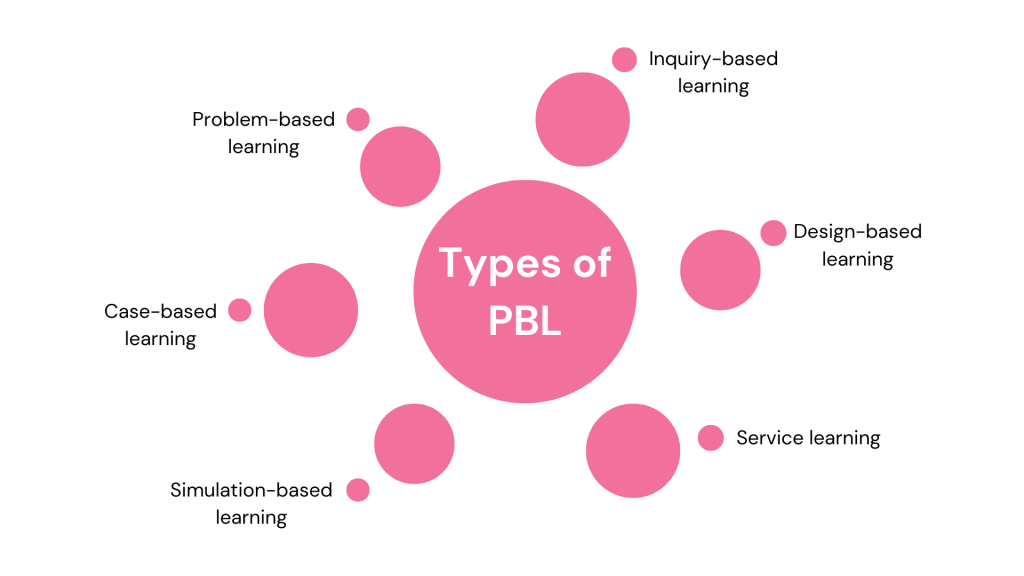
PBL Ideas
Do you want to implement PBL in your class but you don’t know where to start? We mentioned before that PBL programs and activities depend on the students’ learning goals, age, and academic subject. Our main audience are high school and VET students, ages 16-22, here’s a sneak peek on how we work:
At CBE we offer 2 trainings: our Digital Marketing, and our Entrepreneurship Training. They’re aimed at students who are eager to learn more about digital marketing strategies and business-related topics.
The main purpose of these trainings is for students to create a product or business and be able to pitch it professionally by the end of the program. To do so they’ll engage in a series of PBL-based workshops revolving around topics such as Social Media Marketing, SEO, Copywriting or Paid Advertising, and will create marketing materials accordingly.
In order to give you a better picture of what we do and how we do it, here’s an example of the first week of our 4 week Digital Marketing Training:
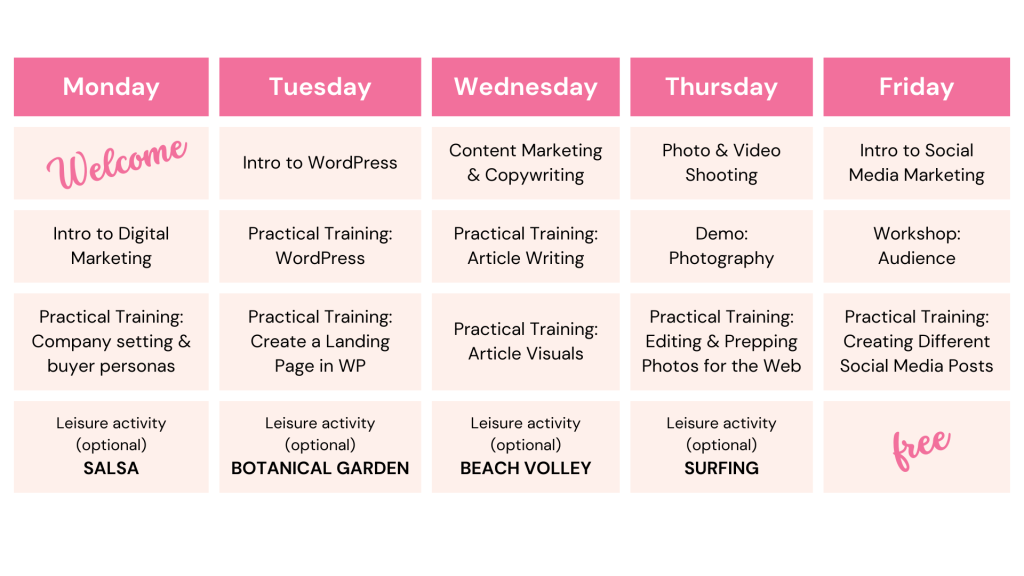
Each day on the program revolves around a specific topic that links to the activities on the next day and the extent of the curriculum.
For example, we start the Digital Marketing Training by introducing students to the concepts of digital marketing, market niches and buyer personas.
By the end of the first day they should have a general idea of what their hypothetical company is going to be about, which products are they going to sell and who are their potential customers.
During the course of the training, students create the necessary marketing materials to promote their company and products, in the form of promotional videos, pictures, social media posts, blog posts, websites and podcasts.
Students work on each specific marketing activity during a whole workshop day. At the end of the Digital Marketing Training, they should have a range of promotional materials with which they should pitch their company and products to “the board”.
The board is composed of Orsolya Vitos, CEO of CareerBridge Europe, Alberto Linares, Project Coordinator at CareerBridge Europe and some of the trainers, depending on their availability.
Project Based Learning for Everyone
Are you a teacher searching for new ways to make your classes more creative and engaging? Then it’s your lucky day. Our partner school, FU International Academy, offers a PBL Training that helps teachers implement PBL in their classrooms and take their classes up to the next level. Learn more here.
Whether it’s for you or your students, your educational institution can participate in all our training courses through the KA1 Erasmus+ program for VET education & learning. The cherry on top: we’re located on the beautiful, tropical island of Tenerife, heart of the Canary Islands (Spain).
All our training courses can be customized depending on the length of your stay and your needs. So what are you waiting for? Enjoy first-class education, while discovering the unique charms this magical island offers its visitors.
Schedule a call with us here to know more about our programs and organization, and embark with us on this amazing learning journey.
